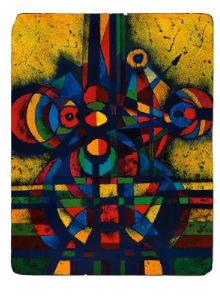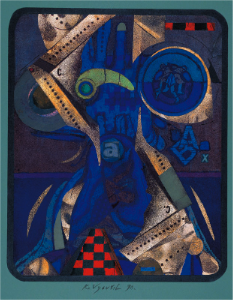
1926-2014
BIOGRAPHICAL DETAILS
1926 – Karel Vysušil was born in Trmice, Bohemia, on 14th November, into the family of Václav and Hermína Vysušil,
1942-1944 – he attended Jaroslav Masák's evening School of Decorative Arts in Vodičkova street in Prague; there he met Richard Fremund, with whom he later shared his own studio in Smíchov,
1945-1947 – he passed exams to study at the Academy of Fine Arts in Prague – began in the studio of professor Karel Minář, later turned to study landscape painting in the studio led by professor Otakar Nejedlý, – met further colleagues of his generation like Robert Piesen and Jitka Kolínská, – alongside which he undertook Art History studies at the Charles University Philosophy Faculty, where he made friends the future art historian František Dvořák,
1946 – he became acquainted with photographer Josef Sudek,
1948 – he built his own studio in Smíchov,
1952 – he became involved in SCUG Hollar and in Association of Graphics Arts,
1954 – he met his life’s love and partner Naďa (Hope), née Karasová (born 1933),
1954-1956 – made friends with members of the future group Máj 57 (May 57), with whom he took part in the first revival presentation Exhibition of the Elevens in ARS hall, Wenceslas Square, Prague,
1956 – the “Máj 57” group was established during December,
1957 – the first exhibition of Máj 57 was opened in May in the Obecní dům (Municipal House) in Prague; also a new group “G7” was established,
1958 - the second exhibition of group Máj 57 in Palác Dunaj (Danube Palace), Národni třída (National boulevard), Prague; the third exhibition of Máj 57 opened in Galerie sztuki nowoczesnej (Gallery of Contemporary Art), Warsaw, Poland; his son Martin was born,
1959 – the first one man show of Karel Vysušil took place in the Hollar Gallery, Prague, and abroad in the Gallery Biberstrasse, Vienna, Austria,
1961 – the fourth exhibition of Máj 57 took place in Pardubice, Bohemia, but Karel Vysušil didn't take part, his interest already leading elsewhere; at the end of year the group disbanded,
1962 – his first participation in the prestige international show Exhibition of Japan Prints, Tokyo, Japan, – he obtained the Silver medal,
1965 – he founded the group LG5 together with typographer J. Týfa and painter Z. Sklenář (the other members were J. Králík and J. Novák),
1966 – he participated in founding Gallery d, Smíchov, which was to underpin the presentation of modern Czech art,
1969 – his one man show in Germany and Switzerland;
1970 – the beginning of the so called “normalisation period” in Czechoslovakia, SCUG Hollar was administratively suspended; – the beginning of traditional meetings in the printing workshop in Říční street, Újezd, Prague Lesser Quarter,
1972 – he exhibited in the Baruch Gallery, Chicago, USA,
1977-1978 – Gallery Butscher organized a one man itinerant show across Germany,
1981 – his next exhibition in Germany,
1986 – a distinct exposition within the framework of a display exhibition of Czech art in Germany,
1990 – exhibitions in Munich and Düsseldorf, Germany,
1993 – exhibited in Holland,
1997 – exhibition in Budapest, Hungary,
1998 – obtained the Franz Kafka Medal from the European Society of Franz Kafka,
1997-2014 – a long string of one man shows in many private and public galleries in the Czech Republic.

Moving back and forth between printmaking and painting, with the printmakers of the Hollar Association and painters of the Máj group, Vysušil's work has developed to the present day. The fact that neither of these techniques dominated in his art was not, however, his intention. Rather, it merely confirms that Vysušil is essentially a painter, who had more opportunities, particularly for exhibition abroad, to express hirnself as a printmaker.
Each of his prints, however, radiates his painterly approach. This is evident even from his first drypoint etchings, which enabled him to join the ranks of professional printmakers. The expressive style of these prints, strongly oriented to the portrait, involves a spatially dramatic construction of free lines. Later, beginning in the 1960s, Vysušil was presented with a new opportunity –colour lithography. These external features of his work alone suggest that Vysušil's printmaking techniques are merely tools for him, and that his painterly approach is always foremost, though he has never been dogmatic about it. On the contrary, he has managed to incorporate that approach with total spontaneity as the predominant value in each of his prints. Related to that, too, is the orientation to realistic topics in the early years of his printmaking, rooted in the observation or study of the human face. It is misleading, however, to describe his early work as "realist", because that fails to express his intimate relationship with "reality". For him, reality was merely a springboard for masterful, free, painterly interpretation. This conception of printmaking is, then, paramount for Vysušil, the fundamental orientation of everything he has considered as an artist.
Consequently, this exhibition is a logical extension of his work, reflecting something that Vysušil has carried within himself throughout his life and also incorporated into truly original collages, which are composed as a dialogue of ideas and materials. He created them in the later phases of his development, without a thought of ever returning to use them in a new visual context years later. They both form a new constellation and are themselves recast in a new artistic language. It's fair to say in this respect that Vysušil can now, on the occasion of his 80th birthday, look back on his work with a sense of having accomplished the artist's mission in today's world, well and with originality.
Dr. Frantisek Dvořák (2006)